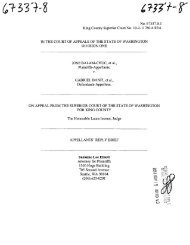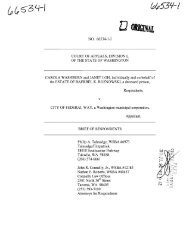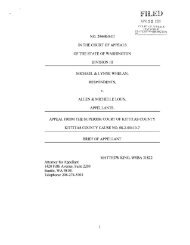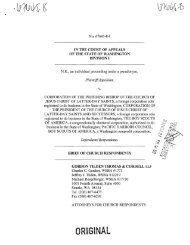Washington State Courts
Washington State Courts
Washington State Courts
You also want an ePaper? Increase the reach of your titles
YUMPU automatically turns print PDFs into web optimized ePapers that Google loves.
conveying his knowledge has enough information to support a reasonable<br />
suspicion of criminal activity. See <strong>State</strong> v. Gaddy, 152 Wn.2d 64, 71, 93<br />
P.3d 872 (2004) (applying fellow officer rule to standard of probable cause<br />
for arrest).<br />
B.-H. disputes the court's conclusion that lohnson's actions did not<br />
exceed the permissible scope of an investigative detention. This Court<br />
reviews conclusions oflaw de novo. <strong>State</strong> v. Doughty, 170 Wn.2d 57, 61,<br />
239 P.3d 573 (2010).<br />
In deciding this question, courts look to the purpose of the stop, the<br />
amount of the intrusion on the suspect's freedom of movement, and the<br />
length of the detention. <strong>State</strong> v. Williams, 102 Wn.2d 733, 740, 689 P.2d<br />
1065 (1984). Factors include the nature of the suspected crime, the degree<br />
of suspicion, the location of the stop, the time of day, and the suspect's<br />
reaction to the police to determine whether the amount of intrusion is<br />
reasonable. <strong>State</strong> v. Belieu, 112 Wn.2d 587, 600, 773 P.2d 46 (1989).<br />
"The investigative methods must be the least intrusive means<br />
reasonably available." Belieu, 112 Wn.2d at 599 . Nevertheless, an<br />
investigative detention does not automatically become an arrest when an<br />
officer points a gun at a suspect. Belieu, 112 Wn.2d at 598-99 (1989)<br />
(citing United <strong>State</strong>s v. Serna-Barreto, 842 F.2d 965 (7th Cir. 1988)). An<br />
-11-
















